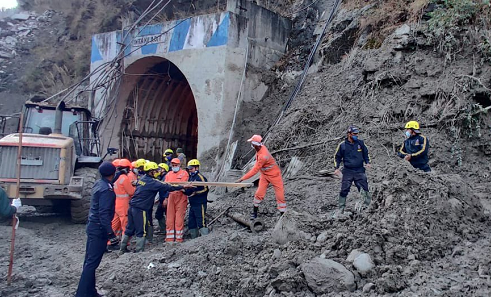New Delhi (ISJ) – The recent flood in Chamoli district of Uttarakhand, triggered by a glacier collapse was not an isolated incident, but the result of a rapidly warming planet, says experts. They warn the disaster, which has left 36 dead and over 200 missing, is a precursor of what is to come unless drastic measures are taken to slow climate change.
Data suggests that, in the coming years, global warming will cause mountain temperatures to rise twice as fast as the global average, whittling away glaciers and threatening communities in the Himalayas, and further downstream.
“Glaciers around the world are under siege,” said Matthias Jurek, a mountain ecosystem expert with the United Nations Environment Programme (UNEP). “Unless we can limit global warming, support monitoring, early warning, and adaptation measures, disasters like the one in Uttarakhand will, unfortunately, become more common.”
In regions like the Himalaya, the problem of rising temperatures is three-fold: it leads to the melting of mountain glaciers, which can spark floods. It also decreases glacial coverage, which leads to a reduction in the long-term availability of water for people, agriculture, and hydropower. Finally, as glacier cover diminishes and the area is replaced by water or land, the albedo – the amount of light that is reflected without being absorbed on a surface – also decreases. This could increase solar energy absorbed, leading to more warming.
Glaciers under siege
Glaciers are often referred to as the “water towers” of the world, with half of humanity depending on mountains for their water needs. The Tibetan Plateau alone is the source of 10 biggest rivers in Asia and provides water to 1.35 billion people, or 20 per cent of the world’s population.
According to data, glaciers were largely in a steady state in the 1960s, but since the 1970s glacial loss has increased rapidly, almost doubling every decade until present. They note that this ice loss “leaves no doubt about ongoing climate change.”
Adaptation action
In the 2015 Paris Agreement, Member States had committed to limit global temperature increases to well below 2°C, and preferably to 1.5°C, compared to pre-industrial levels. Slowing global warming would help save glaciers. But countries must also prepare mountain ecosystems for an inevitable increase in temperatures. The best way is through adaptation, in other words, introduce a change into the ecosystem that will help combat the impact of global warming.
“In mountain ecosystems, our ecosystem-based adaptation projects are restoring forests and shrubs on mountain slopes, which helps prevent both floods and landslides by holding the soil together and regulating the flow of surface water run-off,” said Jessica Troni, Head of the Climate Change Adaptation Unit at UNEP.
While ecosystem-based adaptation projects cannot stop glaciers from melting, they can significantly reduce the disastrous impacts.
“As global warming increases, crop losses and tragedies like the one in Uttarakhand are likely to become more frequent,” said Jurek.
Source: UNEP
Image courtesy: National Disaster Response Force (NDRF)


